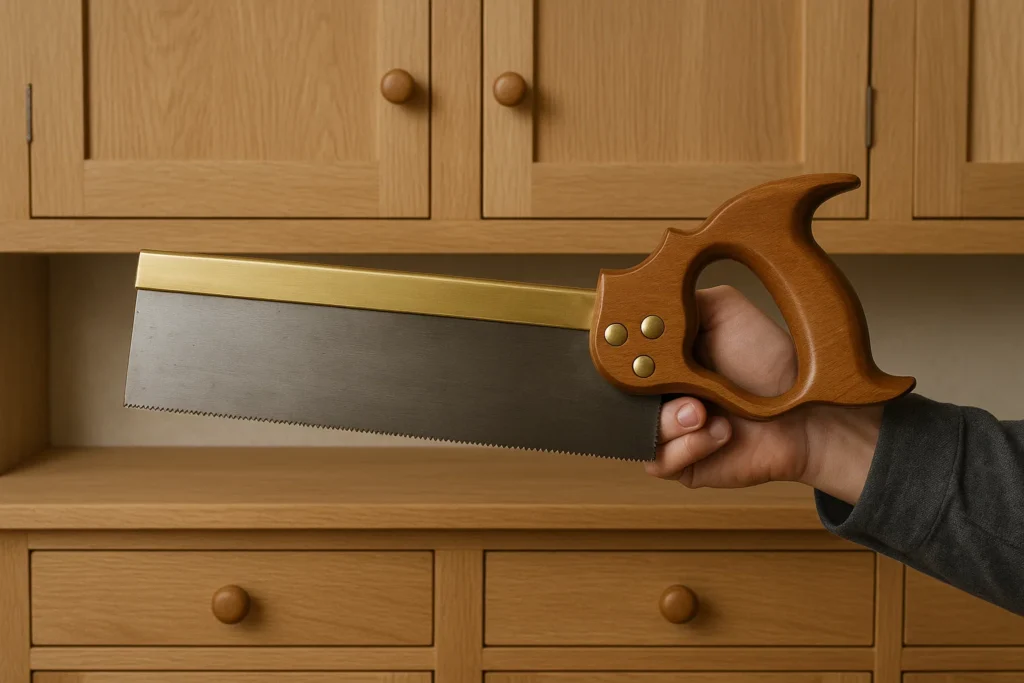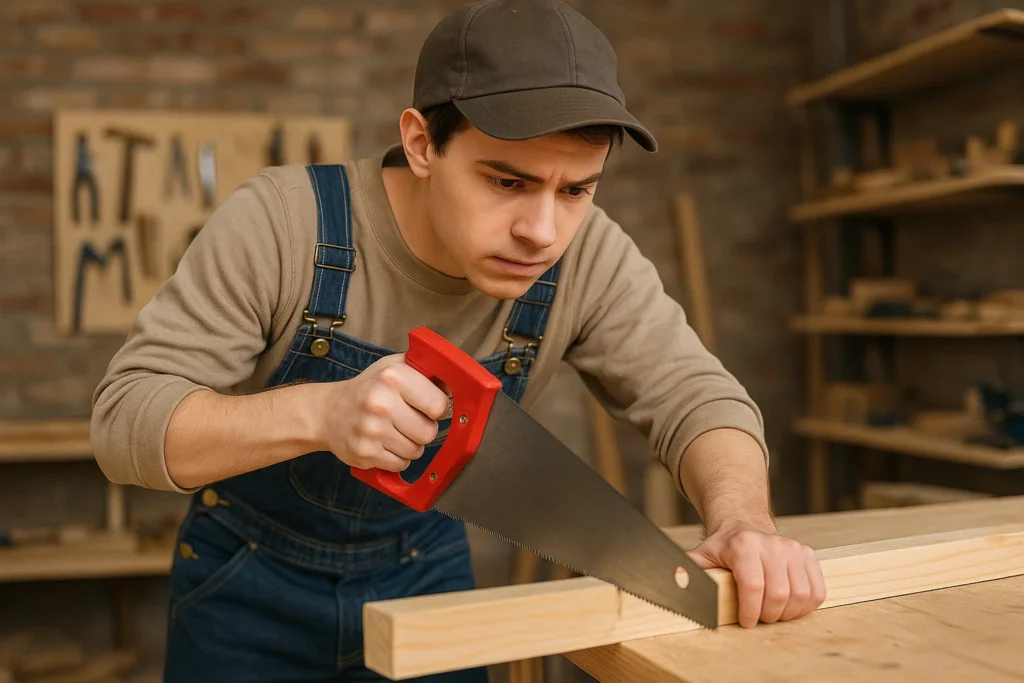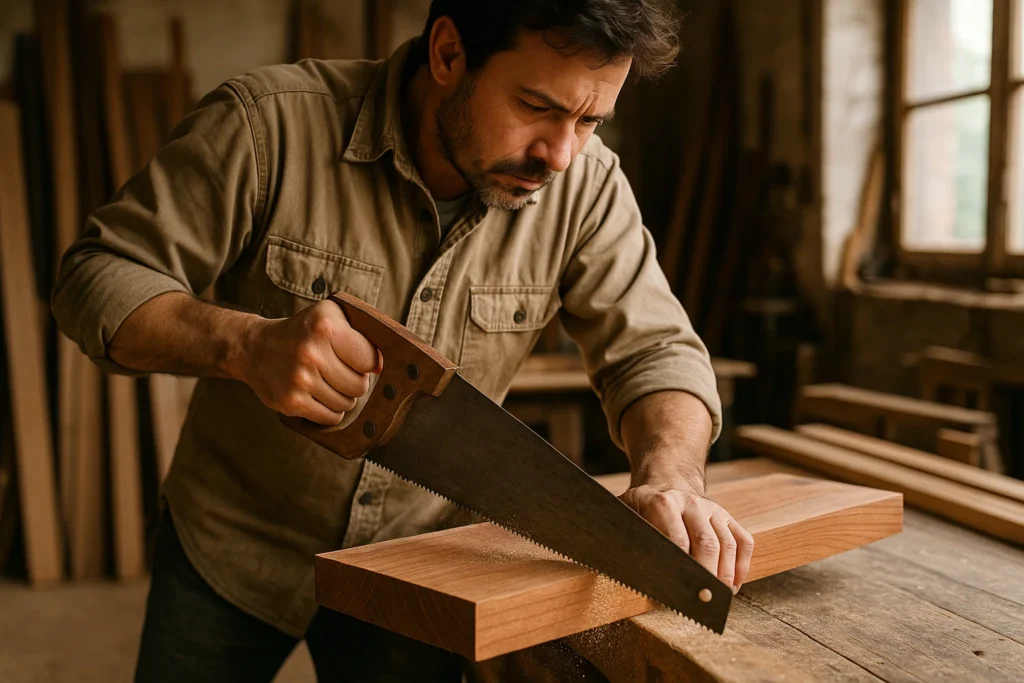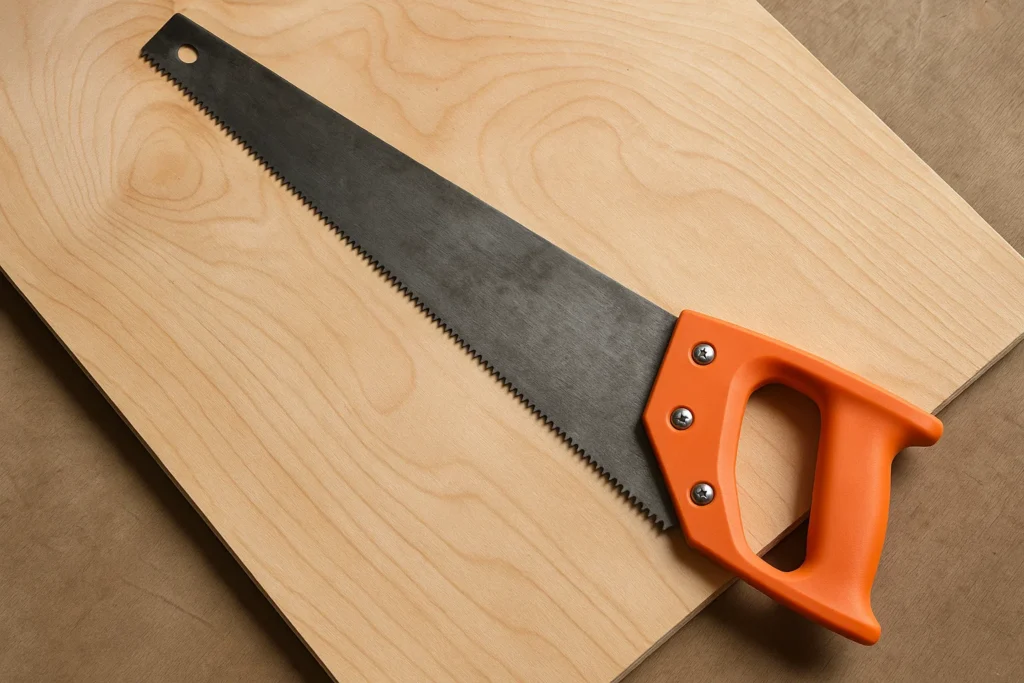The Crown 195 Tenon Saw pairs a rigid brass back and comfy beech handle for accurate cabinetry cuts—just a quick tune brings near‑premium performance at a mid‑range price.
Avoid the Mess
Choosing the right hand saw for cabinetry isn’t just a matter of picking the prettiest handle. A poorly matched blade can lead to tear‑out, uneven joints, and wasted material.
Too fine a kerf may flex and wander; too coarse will leave rough edges you’ll spend hours sanding.
In this guide, we’ll address these pitfalls and help you select a saw that balances precision, durability, and comfort for flawless cabinet work.
Key Takeaways
- The Crown Tenon Saw is our top pick!
- Aim for 12–14 TPI for a balance of cut speed and smoothness.
- Use Japanese pull saws for ultra‑thin kerfs and minimal tear‑out.
- Choose high‑carbon or hardened steel blades for lasting sharpness.
- Opt for a rigid spine (backsaw/tenon saw) to prevent blade flex.
- Prioritize ergonomic, balanced handles to reduce fatigue.
- Match saw style (backsaw, dovetail, pull saw) to your specific joinery task.
Some Images are generated by AI for illustration.
Best Hand Saws For Cabinetry
Hand Saws | Details | Blade Length | TPI |
|---|---|---|---|
12″ (305 mm) | 13 TPI | ||
9.4 ” (240 mm) | N/A | ||
12″ (300 mm) | 11 TPI | ||
12 ” (300 mm) | 13 TPI | ||
12 ” (300 mm) | 15 TPI |
Note: We don’t test products ourselves. Instead, we go through user reviews and/or community discussions to find and recommend the best options.
1. Crown Tenon
The Crown 195 Tenon Saw pairs a rigid brass back and comfy beech handle for accurate cabinetry cuts—just a quick tune brings near‑premium performance at a mid‑range price.
Key Features
- Blade Length: 12″ (305 mm) for extended cutting depth
- TPI: 13 TPI for fine, precise cuts
- Blade Material: High‑carbon steel (resharpenable)
- Handle Type and Material: Full beechwood handle (Fagus sylvatica) secured with screws for a stable grip
- Saw Type: Tenon saw for accurate joinery work
- Weight: 1.65 lb (0.75 kg) for balanced control
Pros & Cons
Pros:
- Cutting Performance: Smooth, precise cuts after tuning for a fine kerf and zero drag (remove protective coating)
- Ergonomics: Comfortable full beechwood handle reduces hand fatigue during extended use
- Rigidity & Stability: Brass back adds weight and rigidity for straighter, wobble‑free cuts
- Value: Premium performance on par with higher‑priced saws at a mid‑range cost
- Durability: Durable construction built to last for decades with occasional resharpening
- Balance: Balanced feel lets the blade “eat” wood with minimal downward pressure
Cons:
- Initial Setup Required: Requires out‑of‑box tuning (coating removal, sharpening, resetting) before optimal performance
- Factory Variance: Factory set can be uneven, leading to inconsistent cuts without adjustment
- Hardware Fit: Occasional fit issues (loose or stripped screws) may offset cutting angle [inspect on arrival]
- Handle Fit: Handle may need reshaping for very large or small hands to achieve perfect comfort
Note: These pros and cons are based on user review trends and latent consensus.
Our Verdict
Here’s the final verdict for the Crown 195 Tenon Saw:
Buy If:
- You want a precise saw for fine joinery and cabinetry work
- You don’t mind a little setup (sharpening and tuning) for top performance
- You value a comfortable beechwood handle and solid brass back for control
- You’re looking for near‑premium results in less than premium price
- You plan to keep and maintain a tool for decades
Don’t Buy If:
- You need a perfectly sharp, ready‑to‑use saw out of the box
- You dislike tweaking tools or lack sharpening tools/skills
- You have very large or very small hands and don’t want to reshape the handle
- You expect flawless factory assembly with no fit‑or‑finish checks
The Crown 195 is a long‑lasting, high‑value tenon saw that delivers precision on par with more expensive models—once you put in the initial tuning work.
It’s ideal for cabinetry enthusiasts who enjoy customizing their tools and want reliable performance for years to come.
2. Gyokucho Razor Saw
Compact folding Japanese Dozuki saw with a high‑speed steel blade and beech handle delivers razor‑sharp, precise cuts ideal for detailed cabinetry. Its sturdy, portable design balances craftsmanship with on‑site convenience.
Key Features
- Blade Length: 9.4 in (240 mm) for deep, precise joinery cuts
- TPI: [Not mentioned] (Impulse‑hardened teeth ensure long‑lasting sharpness)
- Blade Material: High‑speed steel for durable, precise cutting
- Handle Type and Material: Folding solid beech handle with satin lacquer for stable, comfortable grip
- Saw Type: Folding Japanese Dozuki razor saw combining Japanese precision with western backsaw solidity
- Weight: 0.77 lb (350 g) balanced for control and reduced fatigue
Pros & Cons
Pros:
- Solid Construction: Heavier spine and hardwood handle provide a sturdy, balanced feel for precise cabinetry work.
- Smooth, Sharp Cutting: Impulse‑hardened HSS blade maintains sharpness, delivering clean, effortless cuts.
- Fold‑Up Portability: Compact folding design fits easily in tool bags for on‑site joinery tasks.
- Accurate Joinery: Crosscut and rip tooth configuration with rounded tip enables precise halving joints and miters.
- Premium Finish: Beech handle with satin lacquer offers both stability and a refined aesthetic.
Cons:
- Handle Quality Variance: Folding beech handle can sometimes feel inferior to the blade’s craftsmanship.
- Added Weight: Folding mechanism and reinforced spine increase overall weight for prolonged use. (Though, it’s lightweight compared to others)
- Lock Lever Maintenance: Spring‑loaded lever may need occasional adjustment to prevent wobble.
Note: These pros and cons are based on user review trends and latent consensus.
Our Verdict
A precision folding Dozuki that blends Japanese accuracy with solid western backsaw feel—ideal for detail‑oriented cabinetry.
Buy If:
- You need a portable saw for on‑site joinery.
- You value ultra‑clean, smooth cuts in hardwood panels.
- You require a sturdy, balanced feel when cutting miters and laps.
- You appreciate premium hardwood handles and fine craftsmanship.
Don’t Buy If:
- You prioritize an ultra‑light saw.
- You dislike occasional handle or lever maintenance.
- You want a ratherbig saw for cabinetry.
The Gyokucho Folding Japanese Dozuki excels at delivering razor‑sharp, accurate cuts for cabinetmakers who need a reliable, portable tool. Its solid construction and premium finish justify the modest weight and upkeep trade‑offs.
3. Roughneck Hardpoint
The Roughneck R12F tenon saw features a 12" (300 mm) high‑speed steel blade with 11 TPI and a soft‑grip handle for precise, bidirectional cabinetry cuts, offering long‑lasting sharpness at a decent price.
Key Features
- Blade Length: 12″ (300 mm) for deep, precise cuts
- TPI: 11 TPI for smooth, fine cutting with triple‑ground teeth
- Blade Material: High‑speed steel for long‑lasting sharpness
- Handle Type and Material: Soft‑grip handle for comfort and reduced fatigue
- Saw Type: Hardpoint tenon saw cuts on both push and pull strokes
- Weight: 14.3 oz (0.404kg)
Pros & Cons
Pros:
- Precision: Long‑lasting sharpness for precise cuts over extended use thanks to heat‑treated teeth.
- Smooth Action: Effortless push‑and‑pull motion enables accurate tenons and fine joinery.
- Ergonomics: Soft‑grip handle reduces hand fatigue and enhances control during detailed work.
- Build Quality: Exceptional construction delivers reliable performance on timber, melamine, and PVC.
- Value: Balances cost and craftsmanship, offering great value for a hardpoint tenon saw.
Cons:
- Sharpness Consistency: Initial blade sharpness can vary, with occasional units feeling less keen out of the box.
- Price: Slightly higher price point compared to basic budget saws may deter cost‑focused buyers.
- No Feedback: Not many available reviews to make an informed decision.
Note: These pros and cons are based on user review trends and latent consensus.
Our Verdict
Here’s the final verdict.
Buy If:
- You need a sharp saw for precise cabinetry cuts
- You want a comfortable handle for long sessions
- You like cutting on both push and pull strokes
- You value high quality at a budget‑friendly price
Don’t Buy If:
- You require a blade guard for safe storage
- You expect perfect out‑of‑box sharpness without any honing
- You lean heavily on reviews to make a purchasing decision
This tenon saw delivers clean, accurate cuts and stays sharp over time, making it a great choice for most cabinetmakers. Just be ready to tune the edge if needed and provide your own blade cover for safe storage.
4. BAHCO Prizecut
Reliable 13 TPI backsaw offering crisp, accurate cuts and long‑lasting sharpness at an entry‑level price—ideal for basic cabinetry and trim work. Compact, rigid design excels in miter boxes but may lack the finesse for ultra‑fine joinery.
Key Features
- Blade Length: 12 in (300 mm) for precise cuts in small workpieces
- TPI: 13 TPI for smooth cutting of fine and medium‑thickness materials
- Blade Material: Steel for durability and long‑lasting sharpness
- Handle Type and Material: Screwed one‑piece plastic handle for a stable, comfortable grip
- Saw Type: Backsaw for accurate mitre and guide sawing
- Weight: 0.86 lb (0.39 kg) for easy control and reduced fatigue
Pros & Cons
Pros:
- Precision: Precise miter cuts in a guide box for accurate joinery and trim work.
- Durability: Hardpoint teeth stay sharp longer, delivering smooth finishes.
- Ergonomics: One‑piece plastic handle offers a stable, comfortable grip over extended use.
- Stability: Heavy steel back keeps the blade rigid and straight, reducing flex in cuts.
- Value: Affordable price point delivers professional‑level results for basic cabinetry tasks.
- Protection: Reusable plastic tooth guard safeguards the blade during storage and transport.
Cons:
- Precision Limit: Cut precision lags behind fine Japanese saws, limiting ultra‑fine cabinetry work.
- Clogging: Kerf can clog during cuts, requiring manual clearing for uninterrupted strokes.
- Handle Comfort: Plastic handle may feel less sturdy and comfortable over long sessions.
- Hardness Uncertainty: Exact tooth tempering isn’t clearly shown in specs, leaving blade hardness in question. (It does say “hard point”)
- Finish Quality: Longer teeth can produce a rougher cut edge on very fine work.
Note: These pros and cons are based on user review trends and latent consensus.
Our Verdict
A reliable backsaw that balances accuracy and value for basic cabinetry tasks.
Buy If:
- You use a miter box for precise angled cuts
- You need a sharp blade that stays sharp on medium‑thickness wood
- You want a rigid blade that resists flex for straight cuts
- You’re on a budget but still want pro‑level results
Don’t Buy If:
- You need ultra‑fine finish work beyond 13 TPI capability
- You prefer a lighter, pull‑style Japanese saw for delicate joinery
- You often cut very soft or intricate moldings requiring cleaner kerfs
The Bahco NP‑12‑TEN delivers solid accuracy and long‑lasting sharpness at an entry‑level price, making it a great choice for basic cabinetry and trim work. It may not satisfy ultra‑fine finishing or specialist joinery, so consider a higher‑tpi or Japanese-style saw if you need extra finesse.
5. Navaris Tenon
Navaris tenon saw is a 12 in steel back saw with fine teeth and a soft TPR handle for precise pull‑cuts in wood, plywood, and PVC. It’s lightweight, compact, and wallet‑friendly for DIY cabinet work.
Key Features
- Blade Length: 12 in (30 cm) blade ensures precise, controlled cuts
- TPI: 15 TPI
- Blade Material: Steel blade for long‑lasting durability
- Handle Type and Material: Soft rubberized TPR handle for a comfortable, non‑slip grip
- Saw Type: Tenon back saw optimized for straight, accurate pull cuts
- Weight: 0.77 lb (0.35 kg) for easy maneuvering and reduced fatigue
Pros & Cons
Pros:
- Ergonomic Comfort: Comfortable grip from the soft TPR handle reduces hand fatigue during extended use.
- Clean, Accurate Cuts: Sharp steel blade delivers precise pull‑cut lines for small to medium projects.
- Feather‑light Maneuverability: Lightweight design (0.77 lb/0.35 kg) makes working in tight cabinet spaces easier.
- Space‑saving Profile: Compact back‑saw shape fits neatly in toolboxes and workstations.
- Multi‑material Versatility: Capable of cutting wood, plywood, chipboard, and PVC without tool changes.
- Budget‑friendly Value: Offers excellent performance at an affordable price for DIYers and occasional pros.
Cons:
- Flexibility Under Pressure: Blade feels thin and can bend or flex when starting cuts in harder woods.
- Coarse Tooth Finish: Tooth set is too aggressive for a “fine” tenon saw, resulting in rough edges and tear‑out.
- Single‑direction Limitation: Pull‑only cutting action forces frequent repositioning in solid wood, slowing progress.
- Basic Reinforcement: Tinplate back strip may lack the rigidity needed for precise miter‑box work.
- Edge Durability: Relatively soft blade metal wears down quickly under heavy use.
Note: These pros and cons are based on user review trends and latent consensus.
Our Verdict
A handy, budget-friendly backsaw for basic cabinet work.
Buy If:
- You need a lightweight saw for small to medium cabinetry cuts
- You value a comfortable, non‑slip grip for longer projects
- You work with various materials like plywood or PVC
- You want a low‑cost tool for occasional DIY or touch‑ups
Don’t Buy If:
- You require ultra‑fine cuts and minimal tear‑out
- You do heavy daily professional cabinetmaking
- You need a super‑rigid blade for precise miter‑box work
This Navaris tenon saw delivers good comfort and clean pull‑cuts at a very affordable price, making it great for hobbyists and light cabinet tasks. Professionals or anyone needing ultra‑fine, heavy‑duty performance may want a higher‑end backsaw.
Key Features to Look For
When you’re selecting a hand saw for fine cabinetry work, four core attributes determine whether you’ll coax clean, accurate cuts or wrestle with chatter, tear‑out, and fatigue.
1. Blade Type & Tooth Geometry
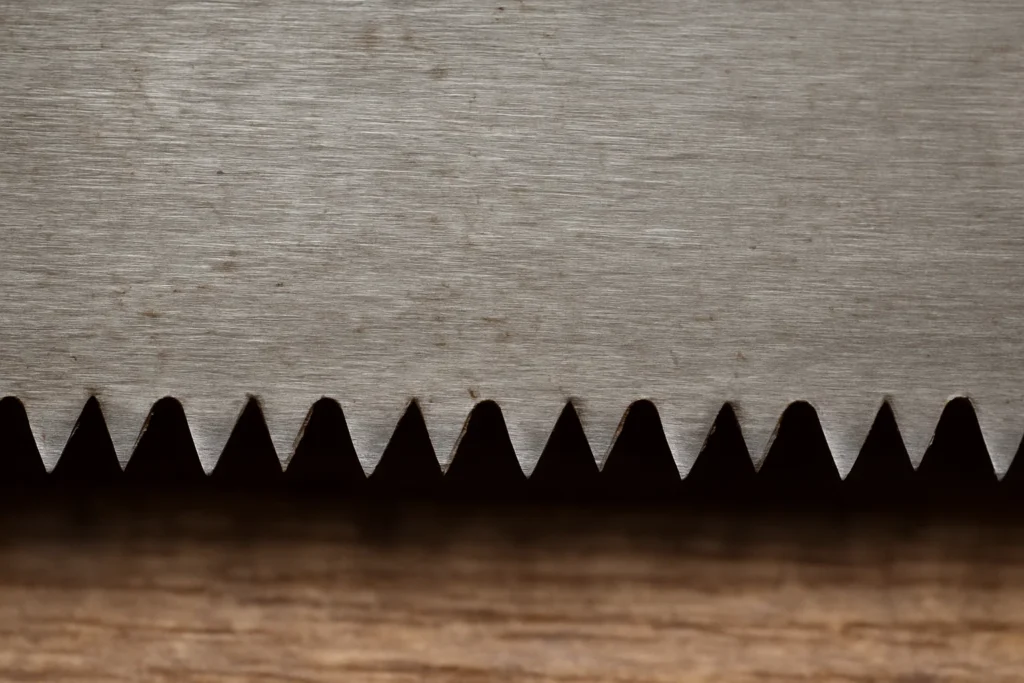
Having the right blade type and tooth geometry is key to finding the right saw. Not just in cabinetry, but woodworking in general.
Rip vs. Crosscut vs. Hybrid:
- Rip teeth (chisel‑like points) slice along the grain, removing material quickly but leaving a slightly rough edge.
- Crosscut teeth (knife‑like points) sever fibers cleanly across the grain, yielding smoother faces but cutting more slowly in rip applications.
- Hybrid (“combo”) blades mix both for moderate speed and finish in mixed cuts—avoid these if you need razor‑sharp results on one grain direction.
TPI (Teeth Per Inch):
- 10–12 TPI: Aggressive cut, faster but coarser finish—use sparingly on softer woods or when speed trumps finesse.
- 12–14 TPI: The sweet spot for cabinetry: balances cut speed, minimal tear‑out, and manageable effort.
Why not more than 14 TPI?
Too many teeth slow you down and gum up with sawdust. Fewer than 10 TPI leaves a jagged edge you’ll spend hours sanding.
2. Blade Material & Coating
Understand the ideal blade material and coating for cabinetry.
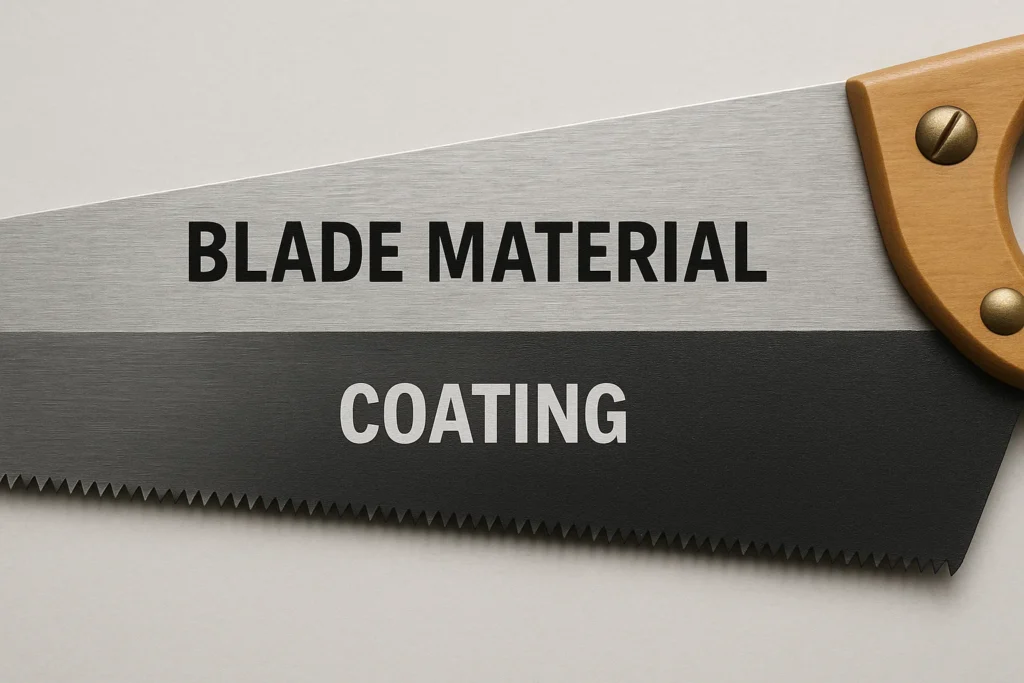
High‑Carbon Steel:
- Holds a death‑sharp edge longer, easy to re‑sharpen at home.
- Slightly more prone to corrosion—dry thoroughly after use.
Hardened Tool Steel:
- Factory‑hardened for extended edge life, resists nicks.
- Sharpening requires specialist stones or services.
Coatings:
- PTFE or Teflon: Reduces friction and pitch build‑up.
- Nickel or chrome plating: Shields against rust.
Tip: A thin, slick coating helps the blade “float” through hardwoods, reducing binding on long pulls.
3. Cutting Precision & Kerf Width
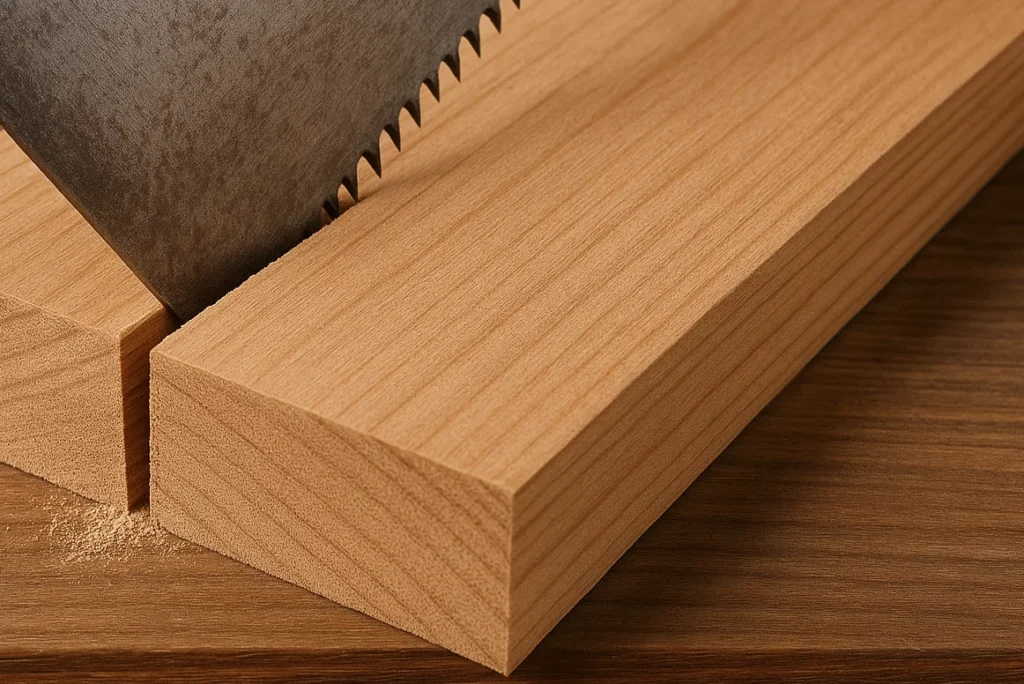
- Kerf width = blade thickness × tooth set.
- Thin kerf (≈0.020ʺ–0.025ʺ): Less material waste, lighter cut, but can flex or wander.
- Standard kerf (≈0.025ʺ–0.030ʺ): More rigid, perfect for long, straight cuts—but you’ll lose an extra few thousandths of an inch per pass.
On delicate joinery, those thousandths add up—opt for a thin‑kerf back saw when precision outweighs speed.
4. Handle Design & Ergonomics
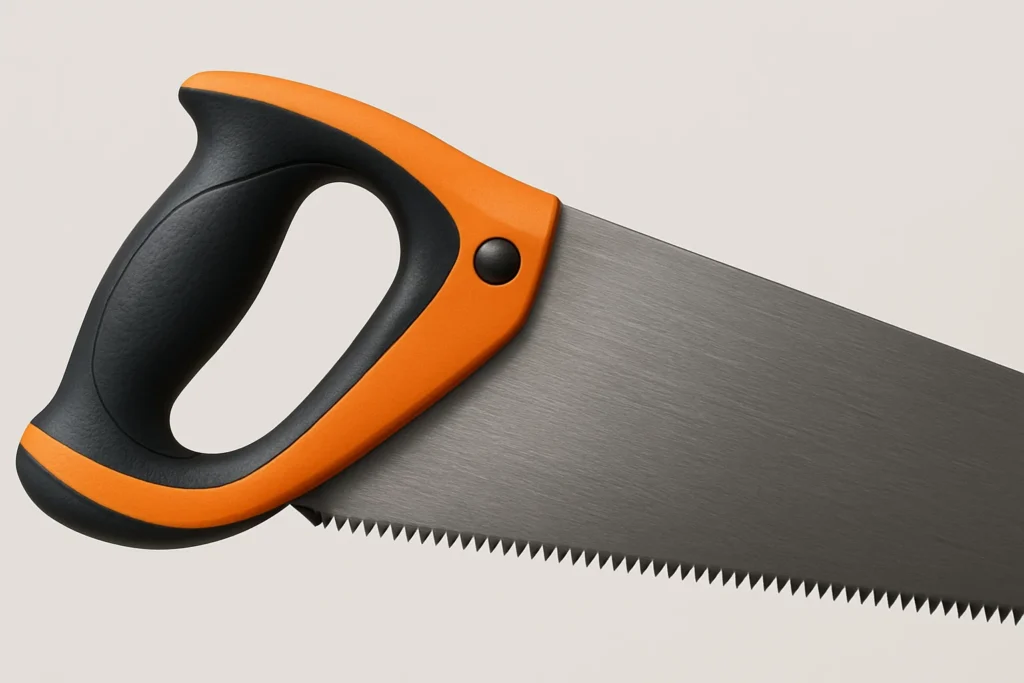
No saw is going to cut if your hand is tired.
Shape & Grip:
- Closed (pistol) grip: Offers better control on push cuts; keeps fingers clear of the plate.
- Open (straight) grip: Allows palm‑down angle for pull‑style saws.
Material:
- Hardwood (beech or rosewood): Feels warm, ages gracefully but can chip.
- Reinforced polymer: Waterproof, impact‑resistant but sometimes slippery.
Balance & Weight:
A perfectly balanced saw feels almost weightless at the tip, reducing arm strain during repetitive pulls.
If your hand flexes or cramps after a few passes, the handle profile or weight distribution isn’t right—test if you can before you buy.
Which Type Of Cabinetry Hand Saws To Use?
Cabinetry calls for saws that combine rigidity, fine teeth, and precise guidance. Below are the three core categories—each built for different joinery tasks—and everything you need to know to choose and use them without hesitation.
1. Back Saws & Tenon Saws
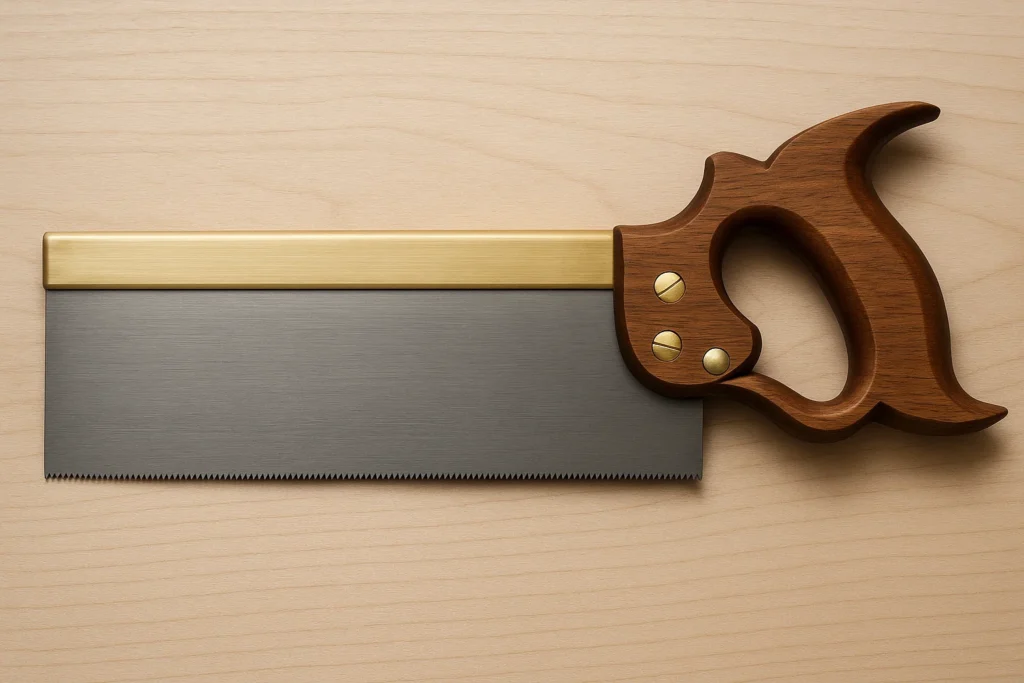
Back saws (sometimes called tenon saws) have a rigid “back” or spine that prevents blade flex. This makes them the go‑to for straight, square cuts in shoulders, tenons, and housing grooves.
Key details:
- Blade length & depth of cut:
- Typical blade: 10–14″ long, spine height 1–1½″ → gives ¾–1″ cutting depth before the spine hits the wood.
- Plate thickness & kerf:
- Plate: ~0.025–0.030″ thick for stiffness. Kerf matches your saw’s tooth set (usually 12–14 TPI) for a neat cut.
- Spine material:
- Steel spine for durability; brass spine for a bit more weight and vintage appeal.
Why use it:
- Square shoulders on tenons and rabbets: Backbone resists bending, so every cut stays dead‑square.
- Fine control: Short, controlled strokes keep you from over‑cutting onto your workpiece.
Ensure your saw plate and spine are firmly soldered or riveted—any wobble equals a wavy cut.
2. Dovetail & Carcass Saws
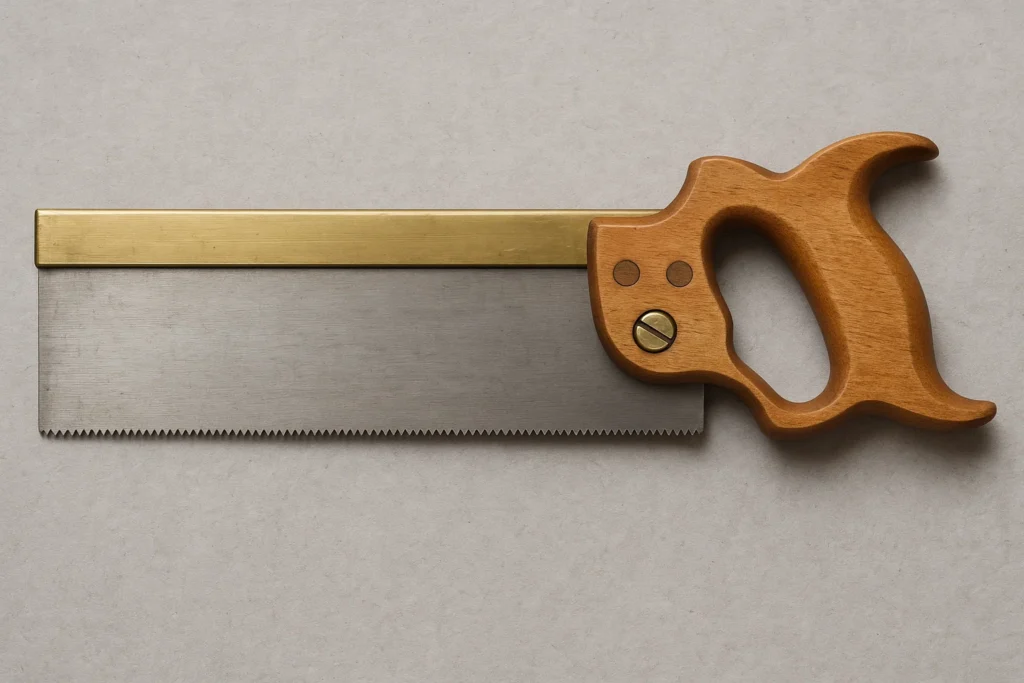
These are narrower, lighter back saws optimized for tight joinery: dovetails, finger joints, and carcass work.
Key details:
- Blade width & belly:
- Blade width tapers from heel (wider) to toe (narrower), letting you pivot into corners easily.
- Tooth count:
- Higher TPI (14–18 TPI) gives razor‑sharp corner definition with minimal chip‑out.
- Handle angle:
- Slight drop or neutral angle to let you saw flat across boards or into angled pins.
Why use it:
- Corner accuracy: Slim profile lets you kerf right up to a marked line without gouging.
- Minimal kerf waste: Less material removed means cleaner fit and tighter glue joints.
Look for a saw with a minimal heel width—this gives more room to start your cut between pins.
3. Japanese Pull Saws
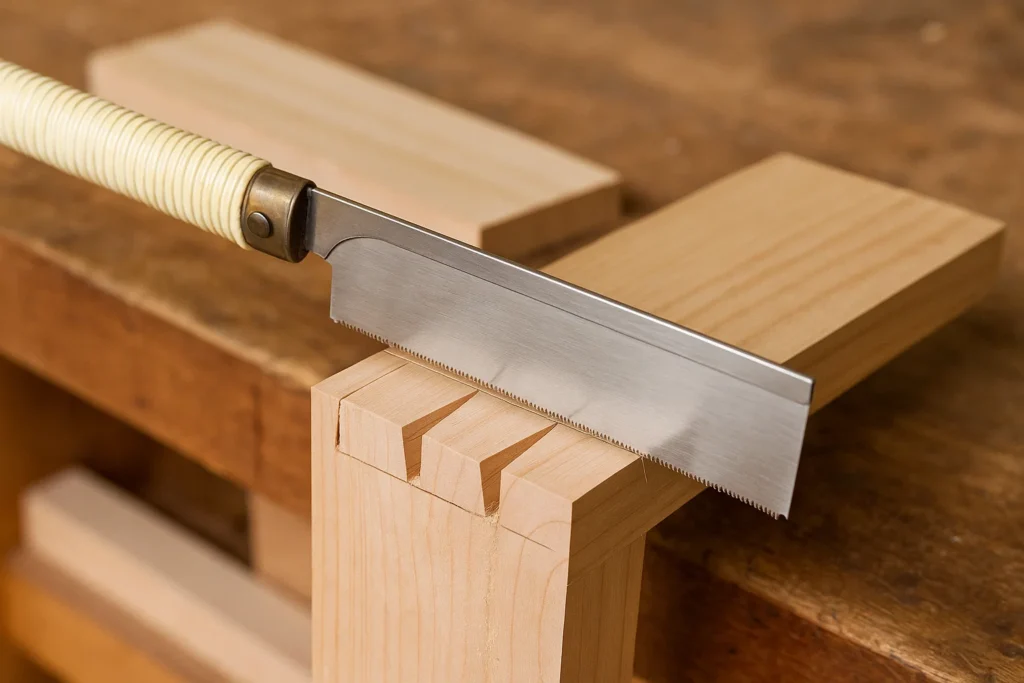
Japanese saws cut on the pull stroke, using thin, double‑bevel plates that stay tensioned only while you pull.
Key details:
- Blade thickness & kerf:
- Ultra‑thin plate (≈0.015–0.020″) for a kerf that wide‑eyed perfectionists adore.
- Tooth geometry:
- Dozuki (backed pull saw): Reinforced spine, 12–15 TPI—ideal for tenons and miters.
- Ryoba (double‑edge): One side rip (8–10 TPI), one side crosscut (15–20 TPI)—versatile for mixed cuts.
- Handle style:
- Straight, lightweight handle encourages precise wrist alignment.
Why use it:
- Cleaner finish: Pull action reduces blade deflection and tear‑out, especially on end grain.
- Less fatigue: You pull with your strongest muscles, giving you better control in small‑scale work.
Because the plate is so thin, always start your kerf with a small back‑cut or guide block to prevent wander.
Conclusion
In the end, choosing the right hand saw for cabinetry comes down to matching blade geometry, kerf width, and handle ergonomics to your joinery needs:
- Blade & Teeth: Aim for 12–14 TPI in a backsaw or tenon saw for clean, controlled cuts—and consider a Japanese pull saw (Dozuki or Ryoba) if you need an ultra‑thin kerf.
- Material & Maintenance: High‑carbon or hardened tool‑steel blades hold a fine edge longer but benefit from periodic sharpening and coating removal.
- Ergonomics & Balance: A comfortable handle and balanced weight reduce fatigue and improve accuracy over long sessions.
Armed with these criteria—and our top picks from budget‑friendly to premium—you’re set to cut tighter joints, work smarter, and enjoy every stroke. Which saw will you try first?
The Crown 195 Tenon Saw pairs a rigid brass back and comfy beech handle for accurate cabinetry cuts—just a quick tune brings near‑premium performance at a mid‑range price.
If you see any kind of mistake in our content, make sure to reach out to us.
Frequently Asked Questions (FAQs)
What saw is best for cutting cabinets?
A cabinet‑style table saw (heavy cast‑iron top, powerful motor) paired with a fine‑tooth crosscut blade and a zero‑clearance insert delivers the straightest, cleanest cuts on plywood or MDF panels.
For on‑site or oversized sheets, a track saw with a splinter‑guard guide rail is an excellent portable alternative.
Why are Japanese saws better?
- Pull‑stroke action keeps the ultra‑thin blade in tension, yielding a finer kerf with minimal tear‑out.
- Higher TPI (often 15–20 TPI) produces smoother finishes, reducing sanding.
- Lightweight design and straight handles improve control and reduce fatigue in detailed joinery.
What handsaw is best for MDF?
A backsaw or tenon saw with 14–18 TPI (or a Japanese Dozuki pull saw) is ideal: the rigid spine prevents blade wander in dense MDF, and the fine teeth leave a clean edge that resists chipping and tear‑out.
What type of saw blade for cabinets?
Use a high‑tooth‑count (60–80 T), carbide‑tipped plywood or melamine blade with an alternating‑top‑bevel grind.
This combination controls tear‑out on veneered or laminated panels and delivers smooth, precise cuts in plywood, MDF, and particleboard.
Can I use a hacksaw to cut MDF?
You can hack it with a hacksaw, but it isn’t ideal:
- Blade geometry: Hacksaw blades (18–32 TPI) are very fine, so they’ll clog quickly in MDF’s dense core and cut extremely slowly.
- Blade stability: Without a rigid spine like a backsaw, a hacksaw wanders easily, so your edges won’t be straight or square.
- Effort & fatigue: You’ll spend far more time and energy than with a powered tool or a proper fine‑tooth saw.
The Grain Bros was started to serve woodworkers who can’t find products for their specific use case. We found out that there are not many media outlets extensively covering this topic. That’s why, we are here, to do the research and find the perfect products for your next DIY project. So you don’t have to juggle your tools and laptop at the same time.
If you see any kind of mistake in our content, make sure to reach out to us.

